
1. Phase 1 - Virtualization Overview
1.1. 1. Industry & Market Overview
1.1.1. Evolution of 3rd Platform & The changing face of server diversity
1.1.1.1. .
1.1.1.1.1. Each platform builds on the previous
1.1.1.1.2. 2nd platform will still live on - but transition to 3rd overall
1.1.1.2. .
1.1.1.2.1. ARM will be coming slowly over time
1.1.1.2.2. Very much as an industry focus on x86 Architecture
1.1.1.2.3. Windows is RED in bottom right image
1.1.1.3. .
1.1.1.3.1. Large scale mostly in North America
1.2. 2. The Impact of Virtualization
1.2.1. Virtualization rates
1.2.1.1. .
1.2.1.1.1. Single POF is a big concern for Virtualized Infrastructure
1.2.1.2. .
1.2.1.2.1. Density optimized pulls down overall virtualization
1.2.1.2.2. Think server farms - Google/Facebook etc. Not virtualized
1.2.1.2.3. More and more VMs per host
1.2.1.3. .
1.2.1.3.1. VM Servers grows slower, but VMs per host increases
1.2.1.3.2. Makes each host more valuable
1.2.1.4. .
1.2.1.4.1. Note how low the Industrial section is!
1.2.1.4.2. HPC - High performance computing - less chance for virtualization
1.2.1.4.3. Physical server view - not indicitive of hosts
1.3. 4. Essential Guidance
1.3.1. .
1.3.1.1. Compare low impact vs high impact workloads
1.3.1.2. What NEEDS higher availability?
1.3.1.3. Growth of density is much higher thatn # of servers. It's more about workloads / critical VMs
1.3.1.4. KEY POINT - 1/3rd of servers support 80% of workloads!
1.4. 3. The Changing Face of Availability
1.4.1. How the risk has changed, What customers are doing, What virtualized infrastructure does and does not do
1.4.1.1. .
1.4.1.1.1. Reduce hardware spend dramatically - net savings
1.4.1.1.2. After consolidation - focus on reliability and performance
1.4.1.2. .
1.4.1.2.1. Over provisioning is an issue with non-virtualized infrastructure
1.4.1.2.2. Live Migration
1.4.1.2.3. Host maintenance
1.4.1.2.4. Workload balancing
1.4.1.2.5. Big IT benefits
1.4.1.2.6. Recovery from outages - more workable disaster recovery plan
1.4.1.3. .
1.4.1.3.1. 3rd party tools often needed
1.4.1.3.2. Not always instant
1.5. Overview
1.5.1. Title
1.5.2. .
2. Other Notes...
2.1. Virtualization is becoming more popular for smaller companies,
2.2. VMs will live on for a long time - will be hosted in cloud and migrated and consolidated heavier
2.3. EverRun Enterprise runs on KVM (Linux Distro)
2.4. EverRun Enterprise works in a pair mode - not 3
2.5. Cloud Solutions have failover to a failover --> rolling availability with 3 + server solution
2.6. Typical Install - Make it as simple as possible
2.6.1. Pair of servers - install both servers
2.6.2. Layer on OS and application
2.6.3. Replication and then up and running
2.7. Trial - They are available - contact Stratus and they can set it up
3. Phase 2 - Stratus Offerings
3.1. Overview
3.1.1. .
3.1.1.1. FT Server - High availability hardware with immediate failover - lockstep together
3.1.1.2. Transition to IaaS and Private Clouds
3.1.1.3. A hardware based HA is good, but having software based solution is the wave of the future
3.2. The Need.
3.2.1. .
3.2.1.1. People are trying to build HA / Continuity into applications
3.2.1.2. Applications between vendors are different - not compatible or portable
3.2.1.3. Example - Redundant HMI servers (application software solution)
3.2.2. .
3.2.2.1. How do we make it HA..and make it easy
3.2.2.2. Series of components
3.3. Components
3.3.1. Availability Engine
3.3.2. .
3.3.2.1. Holds instances in check - trade off - no data loss
3.3.2.2. Not a migration
3.3.2.3. Instances are in LockStep
3.3.3. .
3.3.4. .
3.3.4.1. Take EverRun and move it to enterprise cloud use cases
3.4. Application Monitoring
3.4.1. .
3.4.2. .
3.5. Cloud solutions
3.5.1. .
3.5.1.1. How to support other hypervisors as well?
3.5.1.2. Multiple levels of HA
3.5.1.3. Dynamically provision throughout lifecycles
3.5.2. .
3.5.3. .
3.5.3.1. EverRun enterprise 7.1 is shipping soon

